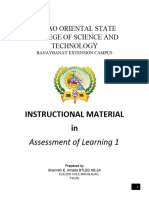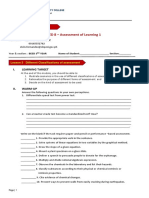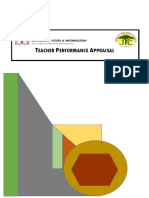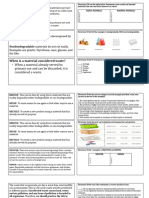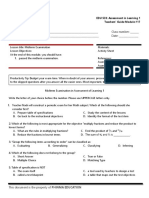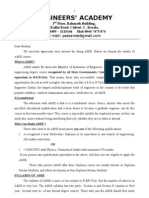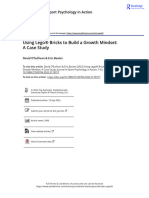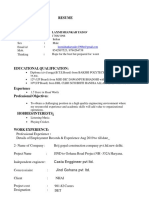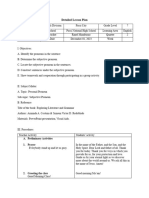Edu 533 Sas#10
Edu 533 Sas#10
Uploaded by
Lalaine Villamar DizonCopyright:
Available Formats
Edu 533 Sas#10
Edu 533 Sas#10
Uploaded by
Lalaine Villamar DizonOriginal Description:
Original Title
Copyright
Available Formats
Share this document
Did you find this document useful?
Is this content inappropriate?
Copyright:
Available Formats
Edu 533 Sas#10
Edu 533 Sas#10
Uploaded by
Lalaine Villamar DizonCopyright:
Available Formats
EDU 533: Assessment in Learning 1
Students’ Module #10
Name: _________________________________________________________________ Class number: _______
Section: ____________ Schedule: ________________________________________ Date: ________________
Lesson title: Planning Written Tests Materials:
Lesson Objectives: reference elementary/secondary
At the end of this module, I can: textbook for each student
1. set appropriate instructional objectives for a written test; and
2. prepare a table of specifications for a written test. References:
Productivity Tip:
Set your deadlines. This strategy will help to avoid leaving your study to the last minute, normalize deadlines
and maximize student productivity. Just like effective time management, juggling deadlines is a common
requirement for many senior jobs.
A. LESSON PREVIEW/REVIEW
1) Introduction (2 mins)
At the end of this module, you should be able to demonstrate your knowledge and skills in preparing a
Table of Specifications (TOS) reflective of appropriate instructional objectives.
2) Activity 1: What I Know Chart, part 1 (3 mins)
What do you know about this lesson? Share them on the What I Know chart.
What I Know Questions: What I Learned (Activity 4)
1. What are Table of
Specifications?
2. How do I prepare TOS?
3. How do I write objectives?
This document is the property of PHINMA EDUCATION
EDU 533: Assessment in Learning 1
Students’ Module #10
Name: _________________________________________________________________ Class number: _______
Section: ____________ Schedule: ________________________________________ Date: ________________
B.MAIN LESSON
1) Activity 2: Content Notes (13 mins) Highlight important information as you go through the text.
Defining objectives for assessment. In designing a well-planned written test, first and foremost you should be
able to identify the intended learning outcome in a course where a written test is an appropriate method to use.
These learning outcomes are knowledge, skills, attitudes and values that every student should develop
throughout the course. Clear articulation of learning outcomes is a primary consideration in lesson planning
because it serves as the basis for evaluating the effectiveness of the teaching learning process determined
through testing or assessment. Learning objectives or outcomes are measurable statements that articulate at the
beginning of the course, what students should know and be able to do or value as a result of taking the course.
These learning goals provide the rationale for the curriculum and instruction. They provide teachers the focus
and direction on how the course should be handled, particularly in terms of course content, instruction and
assessment. On the other hand, they provide the students with reasons and motivation to study and persevere.
They give students the opportunities to be aware of what they need to do to be successful in the course, take
control and ownership of their progress, and focus on what they should be learning. Setting objectives for
assessment is the process of establishing direction to guide both the teacher in teaching and the student in
learning.
Objectives for testing. In developing written tests, the cognitive behaviors of learning outcomes are usually
targeted. For cognitive domain, it is important to identify the levels of behavior expected from the students.
Traditionally, Bloom’s Taxonomy was used to classify learning objectives based on the levels of complexity and
specificity of the cognitive behaviors.
With knowledge at the base (lower-
order thinking skill) the categories
progress to comprehension,
application, analysis, synthesis and
evaluation. However, Anderson and
Krathwohl came up with a revised
taxonomy, in which the nouns used to
represent the levels of cognitive
behavior were replaced by verbs, and
the synthesis and evaluation were
switched.
In developing the cognitive domain of
instructional objectives, key verbs can
be used.
This document is the property of PHINMA EDUCATION
EDU 533: Assessment in Learning 1
Students’ Module #10
Name: _________________________________________________________________ Class number: _______
Section: ____________ Schedule: ________________________________________ Date: ________________
Table of Specifications (TOS) sometimes called a test blueprint, is a tool used by teachers to design a test. It is
a table that maps out the test objectives, content, or topics covered by the test; the levels of cognitive behavior
to be measured; the distribution of items; and the test format. It helps ensure that the course’s intended learning
outcomes, assessments and instructions are aligned.
Generally a TOS is prepared before a test is created. However, it is ideal to prepare one even before the start of
instruction. Teachers need to create a TOS for every test that they intend to develop. The test TOS is important
because it does the following:
● ensures that the instructional objectives and what the test captures match
● ensures that the test developer will not overlook details that are considered essential to a good test
● makes developing a test easier and more efficient
● ensures that the test will sample all important content areas and processes
● is useful in planning and organizing
● offers opportunity for teachers and students to clarify achievement expectations
Steps in developing TOS include:
1. Determine the objectives of the test. In general, objectives are identified at the start when the teacher
creates the syllabus. There are 3 types of objectives
a. cognitive- designed to increase an individual’s knowledge, understanding, and awareness
b. affective-aim to change an individual’s attitude towards something desirable
c. psychomotor- designed to build physical or motor skills
In planning for assessment, choose only the objectives that can be best captured by a written test.
Some cognitive objectives are not meant for written tests such as measuring a students fluency
skills, more so assessing psychomotor skills like a student’s balance or speed. These types of
measurements should be done through performance-based assessments
more specifically
2. Determine the coverage of the test. Only topics or concepts that have been covered in class and are
relevant should be included in the test.
3. Calculate the weight for each topic. The weight assigned per topic in the test is based on the relevance
and time spent to cover each topic during the discussion. The percentage of time for a topic in a test is
determined by dividing the time spent for that topic during instruction by the total amount of time
spent for all topics covered in the test. See example on the next page.
4. Determine the number of items for the whole test. Consider the amount of time to be used by the
students should be considered. As a general rule, students are given 30-60 seconds for each item in test
This document is the property of PHINMA EDUCATION
EDU 533: Assessment in Learning 1
Students’ Module #10
Name: _________________________________________________________________ Class number: _______
Section: ____________ Schedule: ________________________________________ Date: ________________
formats with choices. For a 1-hour class, this means that the test should not exceed 60 items. However,
because you need to give time for the paper distribution, and giving instructions, the number of items
should be less (around 50items)
5. Determine the number of items per topic. Here, weights per item should be considered.
Topic # of Time Spent % of Time # of items
Sessions (mins) (weight)
A. Skeletal System 0.5 30 10 5
B. Muscular System 1.5 90 30 15
C. Circulatory System 1.0 60 20 10
D. Respiratory System 0.5 60 10 5
E. Reproductive System 0.5 30 10 5
F. XXX 0.5 30 10 5
G. YYY 0.5 30 10 5
TOTAL 5 sessions 300mins 100% 50 items
Formats of TOS
1. One-way TOS maps out the topics, test objectives, number of hours spent and format, number, and
placement of items. This is easy to develop because it works around the objectives without considering
the different levels of cognitive behaviors. However, this cannot ensure that all levels of cognitive
behaviors that should have been developed by the course are covered in the test.
2. Two-way TOS reflects content, time spent, number of items, levels of cognitive behavior targeted per
test content based on the theory behind cognitive testing. For example, the common framework for
testing at present in the DepEd Classroom Assessment Policy is the Revised Bloom’s Taxonomy (DepED
2015). One advantage of the format is that it allows one to see the levels of cognitive skills and
dimensions of knowledge that are emphasized by the test. It also shows the framework of assessment
used in the development of the test. This is more complex than the one-way format.
This document is the property of PHINMA EDUCATION
EDU 533: Assessment in Learning 1
Students’ Module #10
Name: _________________________________________________________________ Class number: _______
Section: ____________ Schedule: ________________________________________ Date: ________________
Content Time # & % of KD* Level of Cognitive Behavior, Item Format, # and Placement of Items
Spent items
Remember Understand Apply Analize Evaluate Create
XXX 0.5 5 (10%) F 1.3 (#1-3)
C 1.2 (#4-5)
YYY 1.5 15 (30%) F 1.2 (#6-7)
C 1.2(#8-9) 1.2 (#10-
11)
p 1.2 (12- 1.2 (14-15)
13)
M 1.3 (16-17) 11.1 (41) 11.1 (42)
SCORING 1PT PER ITEM 2PTS PER ITEM 3PTS PER ITEM
OVERALL 5 50 (100%) 20 20 10
TOTAL
Legend: KD-Knowledge Dimension (Factual, Conceptual, Procedural, Metacognitive)
3. Three-way TOS This type of TOS reflects the features of one-way and two-way TOS. One advantage of
this format is that it challenges the test writer to classify objectives based on the theory behind
assessment. It also shows the variability of thinking skills targeted by the test. It takes much longer time
to develop this type of TOS. See the format below:
Content Learning Time # of Level of Cognitive Behavior, Item Format, # and Placement of Items
Objective
Spent Items
Remember Understand Apply Analize Evaluate Create
XXX xxx .5hrs 5 (10%) #1-3 (F) #4-5 (C)
Scoring - - - 1 point per item 2 pts per item 5 points per item
Overall 50
TOtal (100%)
This document is the property of PHINMA EDUCATION
EDU 533: Assessment in Learning 1
Students’ Module #10
Name: _________________________________________________________________ Class number: _______
Section: ____________ Schedule: ________________________________________ Date: ________________
2) Activity 3: Skill-building Activities (with answer key) (18 mins + 2 mins checking)
Going back to the objectives of this module, you are expected to design your own TOS reflective of the outcomes
appropriate for testing. This is your time to do your task. You may need a basic education book, subject of your
choice (preferably related to your specialization.)
Task #1 Select the right assessment objectives for a written test for one quarter competencies in the K-12
curriculum of any subject area and level of your choice. Use the template below as your guide. You may use
another sheet of paper to write down or encode then print for submission.
Grade Level Subject Area
Quarter Covered Domains Covered
Content Standards
Performance Standards
Competencies Selected
Code Statement of Topic Test Format Targeted
Competency
3) Activity 4: What I Know Chart, part 2 (2 mins)
You may pause and go back to the first page to complete What I Learned column
4) Activity 5: Check for Understanding (5 mins)
Task 2 (continuation)
Design a table of specifications (TOS) for a written test covering the competencies selected in Task 1
where you know testing is the appropriate method. Use the one-way TOS for this activity. You may use
another sheet of paper or encode using spreadsheets then print for submission.
Rubrics for tasks 1& 2 are on the Key to Corrections
This document is the property of PHINMA EDUCATION
EDU 533: Assessment in Learning 1
Students’ Module #10
Name: _________________________________________________________________ Class number: _______
Section: ____________ Schedule: ________________________________________ Date: ________________
C. LESSON WRAP-UP
1) Activity 6: Thinking about Learning (5 mins)
Remember to write and/ask for clarifications from your teacher.
________________________________________________________________________________________________
When finished, mark module 10.
FAQs
Question: Can teachers skip the preparation of TOS? Why?
A: Anybody can skip the preparation of TOS but this may reduce the purpose to parallel the learning targets
with the assessment targets. Other factors such as time management, proper assessment planning are also
compromised.
KEY TO CORRECTIONS
Activities 3 and 5 may require more time than usual.
Activity 3 rubrics for selecting test objectives
Criteria Indicators 3 2 1 Evaluator’s Rating
Beyond the Meeting the Below the self pee teac
Standards standards standards r her
Complete-ness the ff are given: the needed The needed Some of the
of informa- tion A. grade level information from A- information needed
B. subject area G are given from A-G are information
C. quarter targeted given from A-G are
D. domains covered given
E. content standards
F. performance standards
G. competencies for testing
Acceptability of A. the competencies chosen are better All A-C are satisfied All A-C are Some
work assessed using a given test PLUS the format of satisfied indicators of
B. the format of the test chosen is the work is neat A-C are not
appropriate, given the cognitive behavior satisfied
represented by the competency
C. the work is free from any error like
spelling and grammar
This document is the property of PHINMA EDUCATION
You might also like
- Psychiatric Mental Health Nursing Success PDFDocument558 pagesPsychiatric Mental Health Nursing Success PDFAnne Syny80% (5)
- Module 4 - Planning A Written TestDocument4 pagesModule 4 - Planning A Written TestKat Jornadal100% (3)
- Assessment Purposes, Learning Targets, and Appropriate MethodsDocument12 pagesAssessment Purposes, Learning Targets, and Appropriate MethodsJasper Diñoso Jacosalem100% (3)
- Name: - Section: - Schedule: - Class Number: - DateDocument11 pagesName: - Section: - Schedule: - Class Number: - DateHAICEE ESMUNDONo ratings yet
- CPE106. Module 2. Lesson 2. Designing Meaningful Performance-Based AssessmentDocument12 pagesCPE106. Module 2. Lesson 2. Designing Meaningful Performance-Based AssessmentDavid Brant LaboneteNo ratings yet
- Sas 3 Edu 535Document6 pagesSas 3 Edu 535Reygen TauthoNo ratings yet
- Assessment in Learning Finals LESSON 4 5 6Document10 pagesAssessment in Learning Finals LESSON 4 5 6Vimelyn FranciaNo ratings yet
- Sas 22 Edu 535Document8 pagesSas 22 Edu 535Reygen TauthoNo ratings yet
- Lesson Plan - AoLDocument7 pagesLesson Plan - AoLDymphna Ann CalumpianoNo ratings yet
- SAS Assessment 1 Module 7-1Document8 pagesSAS Assessment 1 Module 7-1Alden Tagupa EscobidoNo ratings yet
- Don Honorio Ventura State University: College of EducationDocument11 pagesDon Honorio Ventura State University: College of EducationRonann Jay CabahugNo ratings yet
- Educ 6 - Chapter 6 Preparation of Classroom AssessmentDocument8 pagesEduc 6 - Chapter 6 Preparation of Classroom AssessmentBhabz KeeNo ratings yet
- Week 2 New BookDocument11 pagesWeek 2 New BookAlma Guillermo EyagoNo ratings yet
- SOFTDocument9 pagesSOFTMr. MagrataNo ratings yet
- Educ 107 Module 1 Assessment in Learning 1 Dorsu Arnado, Sharmen, E.Document25 pagesEduc 107 Module 1 Assessment in Learning 1 Dorsu Arnado, Sharmen, E.perezzzzmay06No ratings yet
- Critical Analysis PDFDocument9 pagesCritical Analysis PDFManpreet KaurNo ratings yet
- Unit Plan TemplateDocument3 pagesUnit Plan TemplateMs Deanna Ponnuthurai100% (1)
- Teaching Music in Elementary GradeDocument5 pagesTeaching Music in Elementary GradePlok PlokNo ratings yet
- Module 3 Principles of High Quality AssessmentDocument9 pagesModule 3 Principles of High Quality AssessmentRycel JucoNo ratings yet
- Module 2b: Subjective Tests Objective:: Various WaysDocument13 pagesModule 2b: Subjective Tests Objective:: Various WaysRHIZZA MAE BONGHANOY HITOSISNo ratings yet
- PROF - ED 8 - Assessment of Learning 1Document7 pagesPROF - ED 8 - Assessment of Learning 1Mark Joseph DacubaNo ratings yet
- Elective-2-Activity-5 (Output)Document4 pagesElective-2-Activity-5 (Output)Rosemarie GaringNo ratings yet
- Oldani Student Work Analysis Protocol FormDocument8 pagesOldani Student Work Analysis Protocol Formapi-549569760No ratings yet
- Module 3 Principles of High Quality AssessmentDocument7 pagesModule 3 Principles of High Quality AssessmentHelen100% (1)
- Dinalupihancampus: Field Study 5Document3 pagesDinalupihancampus: Field Study 5szarielle yumikoNo ratings yet
- 2022.module 2 - Assessment Process and TargetsDocument37 pages2022.module 2 - Assessment Process and TargetsMinh HuệNo ratings yet
- Lesson 2 Policy Guidelines On Classroom Assessment DEPEDDocument81 pagesLesson 2 Policy Guidelines On Classroom Assessment DEPEDmarsiebagunasNo ratings yet
- HTTPSWWW - Deped.gov - PHWP Contentuploads201901Science CG With Tagged Sci Equipment Revised - PDF 3Document14 pagesHTTPSWWW - Deped.gov - PHWP Contentuploads201901Science CG With Tagged Sci Equipment Revised - PDF 3jandi143No ratings yet
- Edu 412 Strategy Based Comprehension Lesson PlanDocument9 pagesEdu 412 Strategy Based Comprehension Lesson Planapi-667056132No ratings yet
- STB Paws Seminar ContractDocument1 pageSTB Paws Seminar Contractapi-261181520No ratings yet
- Topic OutlineDocument10 pagesTopic OutlineウKラAジNミTーHルNo ratings yet
- DLE 912 Lesson Plan Template: Lesson Name: Your Name and Red ID: Grade Level(s) : Duration of LessonDocument4 pagesDLE 912 Lesson Plan Template: Lesson Name: Your Name and Red ID: Grade Level(s) : Duration of LessonEDSEL ALAPAGNo ratings yet
- Unit 7 Assignment Tasks Rev 1 WorkbookDocument30 pagesUnit 7 Assignment Tasks Rev 1 Workbookمیاں مبشرNo ratings yet
- Module 10 Educ 61chapter 4 Designing Meaningful PBA 1Document7 pagesModule 10 Educ 61chapter 4 Designing Meaningful PBA 1Markdell UndagNo ratings yet
- Course Syllabus EDUC 61 REVISED2019Document11 pagesCourse Syllabus EDUC 61 REVISED2019Mylene VillarNo ratings yet
- Sas #10 - Edu 535Document6 pagesSas #10 - Edu 535nili.gemilo.cocNo ratings yet
- Field Study 2Document23 pagesField Study 2theregistrar medinaipilNo ratings yet
- UbD Template - Nontable Version F15Document9 pagesUbD Template - Nontable Version F15Erin CisnerosNo ratings yet
- Assessment of LearningDocument19 pagesAssessment of LearningICS Tanauan, LeyteNo ratings yet
- Davao Del Norte State College: Institute of Teacher EducationDocument32 pagesDavao Del Norte State College: Institute of Teacher EducationPhranxies Jean BlayaNo ratings yet
- Students - Proposal OutlinesDocument6 pagesStudents - Proposal OutlinesMayank Aryanti Ar WhsNo ratings yet
- Assessment in Learning 1 As of Augist 8 2021Document94 pagesAssessment in Learning 1 As of Augist 8 2021Rajiv Domingo67% (3)
- Chapter 4 Designing Meaningful Perforamnce Based AssessmentDocument13 pagesChapter 4 Designing Meaningful Perforamnce Based AssessmentJA Loayon Beberino100% (1)
- Ele 27 - M1L1 Lastname - Given NameDocument6 pagesEle 27 - M1L1 Lastname - Given NameJessa Mae Lopez DonayreNo ratings yet
- POLICY GUIDELIN WPS OfficeDocument21 pagesPOLICY GUIDELIN WPS OfficeCathy Mary AquinoNo ratings yet
- Why Are Teachers Required of Lesson Plan/course Syllabi and Other Forms of Instructional Plan?Document13 pagesWhy Are Teachers Required of Lesson Plan/course Syllabi and Other Forms of Instructional Plan?Eva NolascoNo ratings yet
- Assessment in Learning 1 With Focus On TM I: Davao Oriental State College of Science and TechnologyDocument37 pagesAssessment in Learning 1 With Focus On TM I: Davao Oriental State College of Science and TechnologyIris PontoNo ratings yet
- 2016 TCHE2401 Method1StudyCourseGuideDocument12 pages2016 TCHE2401 Method1StudyCourseGuidefelfelrocksNo ratings yet
- Curriculum Planning, Design, and Organization: Unit IiDocument12 pagesCurriculum Planning, Design, and Organization: Unit IiSuga MinNo ratings yet
- Activity 6 SolomonDocument9 pagesActivity 6 Solomon20bgu1299msNo ratings yet
- Chapter 4 Performance Based AssessmentDocument43 pagesChapter 4 Performance Based Assessmentyoyiyyiiyiy33% (3)
- Sas 8 Edu 535Document7 pagesSas 8 Edu 535Reygen TauthoNo ratings yet
- Assignment Lesson 1 Checking For UnderstandingDocument2 pagesAssignment Lesson 1 Checking For UnderstandingJulie Ann GinesNo ratings yet
- Teachers Appraisal Instrument Mar.2020Document11 pagesTeachers Appraisal Instrument Mar.2020Ricardo Sage2 Harris100% (2)
- EDU 106 HandoutsDocument8 pagesEDU 106 HandoutsSittie Anna-Arbaya DatudaculaNo ratings yet
- Sas #15 - Edu 535Document10 pagesSas #15 - Edu 535nili.gemilo.cocNo ratings yet
- GENERAL BULLETIN 202 - 2020 - Teachers Appraisal InstrumentDocument11 pagesGENERAL BULLETIN 202 - 2020 - Teachers Appraisal InstrumentDane SinclairNo ratings yet
- Pe 7Document18 pagesPe 7Ely Mar IcawatNo ratings yet
- Topic 3 Authentic Assessment ToolsDocument14 pagesTopic 3 Authentic Assessment ToolsHyacinth Kaye NovalNo ratings yet
- How to Practice Before Exams: A Comprehensive Guide to Mastering Study Techniques, Time Management, and Stress Relief for Exam SuccessFrom EverandHow to Practice Before Exams: A Comprehensive Guide to Mastering Study Techniques, Time Management, and Stress Relief for Exam SuccessNo ratings yet
- Science Wheel CardsDocument37 pagesScience Wheel CardsLalaine Villamar DizonNo ratings yet
- Math CardsDocument5 pagesMath CardsLalaine Villamar DizonNo ratings yet
- Edu 533 Sas#8Document2 pagesEdu 533 Sas#8Lalaine Villamar DizonNo ratings yet
- Edu 533 Sas#17Document8 pagesEdu 533 Sas#17Lalaine Villamar DizonNo ratings yet
- AmieDocument17 pagesAmielazeez.co.in86% (7)
- Using Lego Bricks To Build A Growth Mindset A Case StudyDocument12 pagesUsing Lego Bricks To Build A Growth Mindset A Case Studybhavana.sd86No ratings yet
- Ace Supriatna CV For MayoraDocument1 pageAce Supriatna CV For MayoraAce SupriatnaNo ratings yet
- ACCREDITATION CETSO 2022 2023 Table of Contents Letters 1Document7 pagesACCREDITATION CETSO 2022 2023 Table of Contents Letters 1Ron FamilaranNo ratings yet
- Splitup I VIIIDocument721 pagesSplitup I VIIIsunjeetverma_6937014No ratings yet
- Virginia Commonwealth University Affirmative Action 'Work Around' EmailsDocument100 pagesVirginia Commonwealth University Affirmative Action 'Work Around' EmailsThe College Fix100% (1)
- Session PlanDocument2 pagesSession PlanJay VargasNo ratings yet
- Emarking Notes For SSC IIDocument61 pagesEmarking Notes For SSC IISobia ZeeshanNo ratings yet
- Objectives and AssessmentDocument4 pagesObjectives and Assessmentapi-325943973No ratings yet
- Intern Annual16Document7 pagesIntern Annual16Akash PanwarNo ratings yet
- Tugas B.inggris DasarDocument4 pagesTugas B.inggris DasarAngelina Della FitriNo ratings yet
- "Sport Diplomacy Academy" 2018-1-EACS-EMS-000114, Erasmus+ Programme, Funded by European CommissionDocument3 pages"Sport Diplomacy Academy" 2018-1-EACS-EMS-000114, Erasmus+ Programme, Funded by European CommissionBenja5300No ratings yet
- 2005-05-12Document18 pages2005-05-12The University Daily KansanNo ratings yet
- EFL Blogging School Project Outcomes, 2016Document8 pagesEFL Blogging School Project Outcomes, 2016Oli4kaNo ratings yet
- Has Guidebook LastDocument56 pagesHas Guidebook Lastgeorgesways247No ratings yet
- Parent Teacher ConferenceDocument2 pagesParent Teacher ConferenceRandell AngelesNo ratings yet
- OB Interview AssignmentDocument4 pagesOB Interview AssignmentWeldon D'souzaNo ratings yet
- The Problem and It's BackgroundDocument112 pagesThe Problem and It's BackgroundJeddalyn Yzzabelle JeonNo ratings yet
- An Inspector CallsDocument14 pagesAn Inspector CallsFrances Gillen100% (1)
- Lakshmi ResumeDocument3 pagesLakshmi ResumeAyan DuttaNo ratings yet
- Autrey Mill Middle School One Pager 2022-2023Document1 pageAutrey Mill Middle School One Pager 2022-2023api-651651042No ratings yet
- Detailed Lesson PlanDocument9 pagesDetailed Lesson PlanbjkaunlaranbambangbranchNo ratings yet
- Lesson PlanDocument3 pagesLesson Planapi-404434582No ratings yet
- Session 6 The Youth Program OutfitDocument23 pagesSession 6 The Youth Program OutfitLanuza SonnyNo ratings yet
- Technical Proposal On Psychology, Personal Development, Business and LeadershipDocument24 pagesTechnical Proposal On Psychology, Personal Development, Business and LeadershipMaxbridge Education and Development100% (1)
- Aem 202 Main Text 222Document132 pagesAem 202 Main Text 222Azima SalisNo ratings yet
- Characteristics of HypothesisDocument3 pagesCharacteristics of HypothesisPankaj2c100% (2)
- Fortnightly Progress Report B.Tech. (Ps - , A.Y. 20 - ) : Industrial Practice School:K. L. UniversityDocument1 pageFortnightly Progress Report B.Tech. (Ps - , A.Y. 20 - ) : Industrial Practice School:K. L. UniversityramkrishnaNo ratings yet
- Monday Tuesday Wednesday Thursday Friday: GRADES 1 To 12 Daily Lesson LogDocument3 pagesMonday Tuesday Wednesday Thursday Friday: GRADES 1 To 12 Daily Lesson LogEG Bitong-AlamaniNo ratings yet














